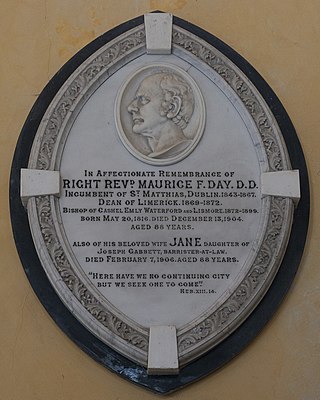
William Monsell, 1st Baron Emly, PC was an Anglo-Irish landowner and Liberal politician. He held a number of ministerial positions between 1852 and 1873, notably as President of the Board of Health in 1857 and as Postmaster General between 1871 and 1873.
Richard Graves (1763–1829) was a Church of Ireland cleric, theological scholar and author of Graves on the Pentateuch. He was a Doctor of Divinity, one of the seven Senior Fellows of Trinity College, Dublin; a member of the Royal Irish Academy; Regius Professor of Greek (Dublin); and Dean of Ardagh. He was the younger brother of Thomas Ryder Graves, Dean of Ardfert and Connor.

Charles Graves was an Irish mathematician, academic, and clergyman. He was Erasmus Smith's Professor of Mathematics at Trinity College Dublin (1843–1862), and was president of the Royal Irish Academy (1861–1866). He served as dean of the Chapel Royal at Dublin Castle, and later as Bishop of Limerick, Ardfert and Aghadoe. He was the brother of both the jurist and mathematician John Graves, and the writer and clergyman Robert Perceval Graves.

Robert Bent Knox was the Church of Ireland Bishop of Down, Connor and Dromore from 1849 to 1886, and then Archbishop of Armagh and Primate of All Ireland from 1886 until his death.

Colonel Thomas de Burgh, always named in his lifetime as Thomas Burgh, was an Anglo-Irish military engineer, architect, and Member of the Parliament of Ireland who served as Surveyor General of Ireland (1700–1730) and designed a number of the large public buildings of Dublin including the old Custom House (1704–6), Trinity College Library (1712–33), Dr Steevens' Hospital (1719), the Linen Hall (1722), and the Royal Barracks.
Harry de Vere Dawson White was an Irish Anglican bishop in the 20th century.

Thomas Elrington was an Irish academic and bishop. He was Donegall Lecturer in Mathematics (1790-1795) at Trinity College Dublin (TCD). While at TCD he also served as Erasmus Smith's Professor of Mathematics (1795–1799) and as Erasmus Smith's Professor of Natural and Experimental Philosophy (1799–1807). Later, he was Provost of Trinity College Dublin (1811-1820), then Bishop of Limerick, Ardfert and Aghadoe (1820-1822), and finally Bishop of Ferns and Leighlin till his death in Liverpool in 1835.

Maurice FitzGerald Day was a Church of Ireland bishop in the last quarter of the 19th century.
The Dean of Limerick and Ardfert is based in the Cathedral Church of St Mary's in Limerick in the united diocese of Limerick, Killaloe and Ardfert within the Church of Ireland. St Brendan's Cathedral, Ardfert was destroyed by fire in 1641.
William Cecil Pery, 1st Baron Glentworth was an 18th-century Anglican bishop in Ireland.
Ulysses Burgh was an Irish Anglican cleric who was Dean of Emly (1685–1692) and Bishop of Ardagh (1692).
Thomas Smyth (1650–1725) was a Church of Ireland clergyman who served as Bishop of Limerick from 1695 to 1725.
Thomas Philip Le Fanu (1784–1845) was an Irish Dean in the first half of the 19th century. He was the son of Joseph Le Fanu and Alicia Sheridan, and the father of Joseph Sheridan Le Fanu and William Richard Le Fanu. He married Emma Lucretia Dobbin.

Edward Newenham Hoare, a graduate of Trinity College, Dublin was an Irish Anglican priest: he was Archdeacon of Ardfert from 1836 to 1839, then Dean of Achonry from 1839 to 1850; and Dean of Waterford from then until his death.
Walter Blake Kirwan (1754–1805) was an Irish priest of the Church of Ireland and a noted preacher.
Rowland Davies (1649–1721) was Church of Ireland dean of Cork.
Michael John Keatinge (1793–1877), also Keating, was a 19th-century Irish Anglican priest. He argued in 1827 that the economic problems of Ireland were largely caused by the system of letting land, with which government should not interfere.
Charles Massy (1695–1766) was Dean of Limerick from 1740 until his death.
Ven. Thomas Bunbury Gough was an Anglo-Irish priest who was Dean of Derry in the Church of Ireland for four decades.
Arthur William Edwards was a nineteenth century Anglican priest.
This page is based on this
Wikipedia article Text is available under the
CC BY-SA 4.0 license; additional terms may apply.
Images, videos and audio are available under their respective licenses.






